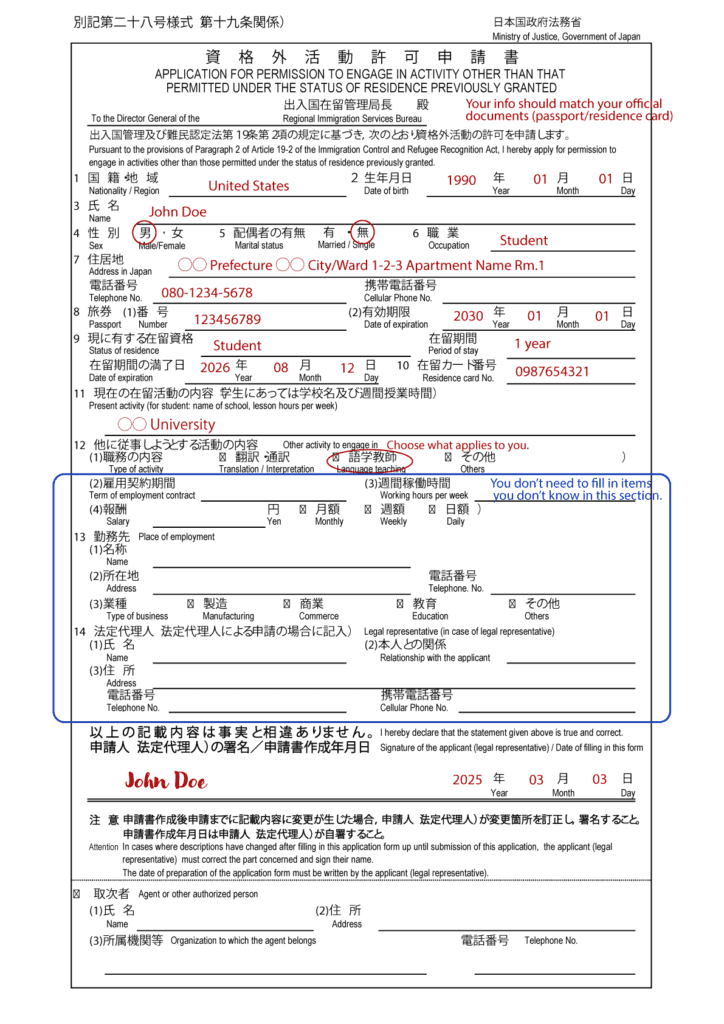So, you want to get a part-time job, but you’re still on a student or dependent visa. Luckily, applying to engage in activities outside the scope of your visa is surprisingly straightforward.
For those unaware, if you come to Japan as an exchange student or dependent, your work opportunities are limited due to your visa type.
Of course, students are supposed to focus on their studies, while dependents should be financially dependent on their spouse, parent, or other family members.
But even if you fall into one of these categories, you can apply for ‘permission to engage in activities’ outside of your visa type. Here’s how.
What is ‘Permission to Engage in Activities’ for?
According to the Ministry of Justice in Japan, if you are a student, dependent, or foreign national under a non-work visa, you have to fill out a ‘Permission to Engage in Activities other than those Permitted by Status of Residence’ form before starting part time work.
In Japanese, it’s called 資格外活動許可 (shikakugai katsudou kyoka).
After you fill out the form, you can take it to your regional immigration office and have permission granted.
If it’s far away, carve out a day to go, especially if you need to take public transit. Bureaucracy in Japan tends to go more smoothly than in the US, but it’s still bureaucracy.
Then, you’re only allowed to work part-time! That’s under 28 hours of work per week. You’re also restricted from working in pachinko parlors, the red light district, or other similar lines of work.
Other visa holders may need this permission as well. For example, if you have a teaching visa but want to do another type of work on the side, or if you’re a foreign national seeking work.
In a nutshell, being a student or dependent means you have to specially apply for permission to work.
I’ve put together this handy information, but always check the most up-to-date information and do your own research.
How to Apply for Permission to Engage in Activities
Applying as a Student

If you’re a student, there are actually two ways you can apply for this work permit.
At the Airport
The easiest way is to apply in the immigration section of the airport. This is where the officer will create your residence card.
Before you leave this section of the airport, present your paperwork, and they should stamp it with a permission-granted stamp.
1. Fill Out the Paperwork
Before you leave your home country, print and fill out the form. If you’re nervous, bring an unfilled copy as well.
Click image to enlarge

2. Present your Paperwork at Immigration
When you arrive at the immigration window, present your request form along with your passport.
They will process your permission along with your residence card. Your residence card is where they will stamp the permit.
At an Immigration Office
If you didn’t apply for permission at the airport, you can still apply in person at your local immigration office.
Some prefectures only have one major immigration office. Other areas, like the different Tokyo wards, will have their own.
You can find yours by searching 入国管理局 (nyuugoku kanrikyoku). The process is the same as for dependents below.
Applying as a Dependent

If you’re a dependent, the only way you can receive the permit is to go in person to your local immigration office.
Do this step before applying for any jobs. Companies need to confirm your eligibility to work before hiring you.
If you can’t speak Japanese, try to arrange a translator or friend to help you go to the office.
Although it’s a bit of a hassle, this process is fairly straightforward and painless once you’ve handed in your application.
The staff should process your documents same-day. Plus, while you’re out and about, you can treat yourself to lunch or a coffee.
At an Immigration Office
1. Prepare your form (same as above)
If you don’t yet have a job, you don’t need to fill in all of the bottom sections.
2. Bring your Documents
For “general” permit:
In addition to your filled form, bring your passport and residence card in a clear folder.
For “individual” permit:
Tip: Individual permits exceed the permission given in a “general permit”. If you only want to work up to 28 hours per week, a general permit will suffice.
- Bring your other documents that explain the scope of your work.
- If you’re a student, include proof of enrollment in your university.
3. Take a number
Go to the immigration office. Wait for your name to be called, and submit your paperwork.
4. Wait again
The officer will call you back up to the window once they’ve confirmed your information.
5. Answer any questions
If everything is confirmed, voila! Your permission has been granted.
My Experience Applying for Permission

In my case, I went to the Utsunomiya Immigration office. I took the bus from my city and walked from the station to the office. It actually gave me a chance to explore downtown.
At the office, you have to get a number ticket. The kiosks were awkwardly located right in front of the clerks, past the waiting room chairs. After asking another person where they were, I could identify the green ticket buttons.
I waited my turn and went up when called. Then I handed in my documents. After the staff reviewed my application, I was called up to clarify a quick question, then approved!
It all-in-all took less than an hour from when I arrived. Keep in mind that I went mid-morning on a weekday, though. Many people were already there, renewing their visas and such, so wait times can be longer.
Afterwards, I got a banh mi for lunch and visited the Mega Don Quijote. Making your boring government office trip a little more fun by visiting a new restaurant or shops is an important part of the experience!
If you’re curious about what it’s like to live in Japan as a dependent, you can check out my previous post.
Or if you’re about to get a job with a more robust visa, like teaching English, check out the 7 Things to Bring on your First Day as an English Teacher in Japan!





Hi Kat! This was very helpful! Did you have to bring a letter/note from your employer confirming your hours and pay? Thank you!
Hi Nikka, I’m glad to hear that! I didn’t need to bring a letter to confirm hours as I was still job-hunting. Though if you have one, it wouldn’t hurt to bring it.